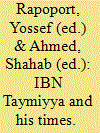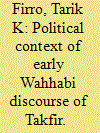| Srl | Item |
| 1 |
ID:
100495


|
|
|
|
|
| Publication |
Karachi, Oxford University Press, 2010.
|
| Description |
xiv, 400p.Hbk
|
| Standard Number |
9780195478341
|
|
|
|
|
|
|
|
|
|
|
|
Copies: C:1/I:0,R:0,Q:0
Circulation
| Accession# | Call# | Current Location | Status | Policy | Location |
| 055525 | 923.25491/RAP 055525 | Main | On Shelf | General | |
|
|
|
|
| 2 |
ID:
126640


|
|
|
|
|
| Publication |
2013.
|
| Summary/Abstract |
This article compares the takfiri discourse (accusing people of being infidels) of the first and second generation of Wahhabi scholars with that of Muhammad Ibn 'Abd al-Wahhab, the founder of the Wahhabiyya. The article shows that these scholars had revised Ibn 'Abd Wahhab's position toward infidelity; a position which had been adopted by many Wahhabi scholars until the beginning of the nineteenth century. In their revision, they put an end to the ambivalent position toward takfir, emphasizing that warfare was the suitable means of interacting with religious and political opponents. To justify their approach, they reinterpreted not only the writings of the founder of Wahhabiyya but also those of Ibn Taymiyya and other Hanbali scholars. Their takfiri discourse remained alive among large segments of the masses and religious scholars in Sa'udi Arabia until today, though some Sa'udi kings and princes sometimes denounced it.
|
|
|
|
|
|
|
|
|
|
|
|
|
|
|
|
| 3 |
ID:
157843


|
|
|
|
|
| Summary/Abstract |
A considerable amount of scholarship has been produced on just over sixty paintings of humans and demons, many of which bear ascriptions to the unidentified artist Mohammad-e Siāh Qalam, and which are now mostly housed in albums H.2153 and H.2160 in the Topkapı Palace Library. Although methods of formal comparison have led to general agreement that the paintings can be dated to either the fourteenth century or the fifteenth, strikingly little attention has been paid to the question of what these images depict. This paper studies the paintings within the context of documentary, legal and literary material in Persian and Arabic, and identifies a set of common motifs shared between the Siāh Qalam paintings and a number of later images. While it has been supposed by several scholars that the paintings document life in a marginal geographical environment and faithfully reflect the practices of a syncretic culture, this paper suggests that they engage with a field of satirical ideas which were widespread in the Islamic world in the fourteenth and fifteenth centuries, and which parodied common types of behavior that were deemed by some observers to be illicit or absurd.
|
|
|
|
|
|
|
|
|
|
|
|
|
|
|
|